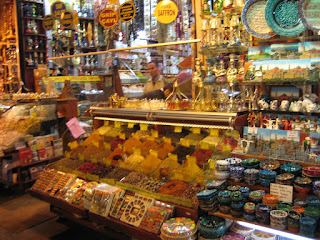Monday, March 21st:
Today we awoke early enough to enjoy the (included) breakfast at the Villa Denise. Breakfast here consists of coffee, lots of bread, jam, three different types of white cheese, black and green olives, honey, butter, coffee, and a roll of salamı (like ham, but nobody in Islamic regions eat pig). After breakfast we went to the Ortaköy Mosque which is right on the Bosphorus. The mosque has a beautiful exterior, has massive minarets, and is decorated with large crystal chandeliers and baroque paintings. As we walked out of the mosque, Jen’s boot zipper broke, so we travelled to her dorm room in Etiler to get her a new pair of shoes. Following that, we took a bus to Beşiktaş to go to the Dolmabahçe Palace, but it was closed (for Mondays), so we walked to Eminönü to check out the famous Spice Bazaar!
The Istanbul Spice Bazaar is a very cool place filled with vendors selling Turkish delights, tea leaves, dried fruits, spices, dried vegetable skins, cheese, olives, and tons of nuts. Most of the Turkish delights are filled with pistachios, which is a huge staple of the nation. It is very enjoyable to walk around because you are allowed to take small, free samples of things without buying the large quantities in which they are typically sold. At the end of the spice bazaar, we bought a Vefa drink, which tastes like applesauce mixed with yogurt with hazelnuts in it. From there we walked up a large hill to the Süleymaniye Mosque which is one of the largest in the city and most prominent as it sits on top of a hill overlooking the Golden Horn River that divides the city. The mosque was constructed for the Ottoman sultan Süleyman the Magnificent. The inside is gorgeous and decorated with typical Ottoman styles much like the Blue Mosque.
After a short taxi (taksi) ride north of the city center, we arrived at the Church of St. Savior at Chora (the Kariye Müzesi). This church is a Byzantine church that is much smaller than the Hagia Sophia, but similar style and interior decoration. The church has a series of small hallways that are decorated from top-to-bottom in religious mosaics. It is absolutely beautiful, and much lower-key than the Hagia Sophia. The mosaics are of similar style but are much closer to the viewer as the building is smaller. It is one of the few remaining churches from the Byzantine era that seemed to avoid Islamic influence and the addition of minarets during their reign.
Jen and I made our way back to the hotel for a short nap before heading out to dinner in Arnavutköy next to the Kuruçeşme Park at a restaurant called Marina Balik. Balik is Turkish for fish, and this restaurant is right on the Bosphorus. My brother, Brad, deserved credit for the recommendation here, as he and his wife, Laura, went here on their birthday (yes, they are both born on the same day) when they visited Istanbul. For dinner we both had Grilled Octopus and an extremely delicious Grilled Salt Fish kebap with tomatoes and peppers. We also enjoyed some Turkish white wine with the dinner, a bottle of “Bornova Misketi,” or Muscat, which was by far the best of the trip so far. We digested our food on the walk back to the hotel, and after some prodding from Jen, we took a few pre-game shots of a Turkish vodka called Binbao, flavored like blood-orange, and went to the club called Reina. Reina is apparently one of the best clubs in the world and especially Europe, and is noted as the best club in Istanbul. The location is awesome, right under the bridge to Asia in Ortaköy, however in the winter months the outside deck is closed as it is too cold. We had heard that the doormen are typically against letting Americans inside, but we got inside. I figured that it being a Monday night and being fairly empty was the reason that this was so easy. We still enjoyed the club very much and stayed dancing until it closed at three in the morning. Just a note to people who want to go here: The club is awesome, the service is great if you get inside, but be prepared for a hefty bill. We drank three gin and tonics between the two of us and it was 100TL for them. Finally it is bedtime after such a long and eventful day!






No comments:
Post a Comment